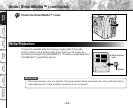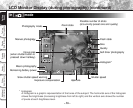
- 40 -
Getting
Ready
Taking
Photographs
Playing
Back Images
Other
Applications
Additional
Information
Erasing
Images
Handy
Functions
How to Press the Shutter Button
The shutter button can be pressed down in two stages: halfway down and fully down. When pressed halfway down,
AF (auto-focus) and AE (auto exposure) are set. When pressed fully down, the camera takes a picture.
Press the shutter button down halfway
1
.
AF (auto-focus) and AE (auto exposure) (➲ Additional Information,
Glossary) start to function.
When AF or AE are locked, the beep tone (➲ Page 111) sounds and the
viewfinder LED turns green.
Press the shutter button down fully
2
.
The camera takes a picture.
The viewfinder LED turns red while image data is being recorded onto
the SmartMedia™.
IMPORTANT
• Never open the SmartMedia™ cover or remove the SmartMedia™ while an image is being recorded. This
may corrupt the data on the SmartMedia™ or damage the SmartMedia™ itself.
Memo
• The image in the LCD monitor sometimes darkens from the time that the shutter button is pressed down
halfway until the image becomes focused.
• To set the focus or exposure for a subject outside the center of the intended image, point the camera directly
at the subject or desired exposure (lighting), press and hold the shutter button halfway. Now, with the shutter
button still held halfway down, you can turn the direction of the camera and frame your image with the focus
and exposure locked. Press the shutter button down fully to complete capturing of the image.
• Moving the camera as you press the shutter button will result in a blurred image.
• The PDR-M81 uses an accurate auto focus mechanism. However, the PDR-M81 may have difficulty
focusing or not be able to focus at all for subjects and situations such as the following:
• If the image cannot be focused, the focus is automatically fixed to infinity. (When the flash is necessary
at this time, it is simultaneously fixed to illuminate objects 1.5 meters (five feet) away. During macro
photography, the flash is aligned with the wide position.)
POWER
Press down
halfway.
Press down
fully.
1
2
- When the subject is distant and dark
- When there are objects in front of or behind the subject
(such as an animal in a cage or a person in front of a tree)
- Subjects with little reflection, such as hair or fur
- Subjects with no solidity, such as smoke or flames
- Subjects viewed through glass
- Subjects moving at high speed
- Very shiny subjects such as a mirror or car body
- Extremely low contrast subjects
- Subjects that have low contrast and merge into
the background (such as white walls or subjects
dressed in the same color as the background)


















